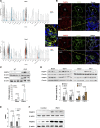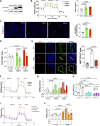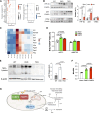Single-Cell and Spatial Transcriptomics Identified Fatty Acid-Binding Proteins Controlling Endothelial Glycolytic and Arterial Programming in Pulmonary Hypertension
- PMID: 40401371
- PMCID: PMC12188824
- DOI: 10.1161/ATVBAHA.124.321173
Single-Cell and Spatial Transcriptomics Identified Fatty Acid-Binding Proteins Controlling Endothelial Glycolytic and Arterial Programming in Pulmonary Hypertension
Abstract
Background: Pulmonary arterial hypertension (PAH) is a devastating disease characterized by obliterative vascular remodeling and persistent increase of vascular resistance, leading to right heart failure and premature death. Understanding the cellular and molecular mechanisms will help develop novel therapeutic approaches for patients with PAH. Recent studies showed that FABP (fatty acid-binding protein) 4 and FABP5 are expressed in endothelial cells (ECs) across multiple tissues, and circulating FABP4 level is elevated in patients with PAH. However, the role of endothelial FABP4/5 in the pathogenesis of PAH remains undetermined.
Methods: FABP4/5 expression was examined in pulmonary arterial ECs and lung tissues from patients with idiopathic PAH and pulmonary hypertension (PH) rat models. Plasma proteome analysis was performed in human PAH samples. Echocardiography, hemodynamics, histology, and immunostaining were performed to evaluate the lung and heart PH phenotypes in Egln1Tie2Cre (CKO) mice and Egln1Tie2Cre/Fabp4/5-/- (TKO) mice. Bulk RNA sequencing (RNA-seq), single-cell RNA sequencing analysis, and spatial transcriptomic analysis were performed to understand the cellular and molecular mechanisms of endothelial FABP4/5-mediated PAH pathogenesis.
Results: Both FABP4 and FABP5 were highly induced in ECs of CKO mice and pulmonary arterial ECs from patients with idiopathic PAH (IPAH) and in whole lungs of PH rats. Plasma levels of FABP4/5 were upregulated in patients with IPAH and directly correlated with severity of hemodynamics and biochemical parameters. Genetic deletion of both Fabp4 and Fabp5 in CKO mice caused a reduction of right ventricular systolic pressure and right ventricular hypertrophy, attenuated pulmonary vascular remodeling, and prevented the right heart failure secondary to PH. FABP4/5 deletion also normalized EC glycolysis and distal arterial programming, reduced reactive oxygen species and HIF (hypoxia-inducible factor)-2α expression, and decreased aberrant EC proliferation in CKO lungs.
Conclusions: PH causes aberrant expression of FABP4/5 in pulmonary ECs, which leads to enhanced EC glycolysis and distal arterial programming, contributing to the accumulation of arterial ECs and vascular remodeling and exacerbating the disease.
Keywords: glycolysis; heart failure; hypoxia; lung; pulmonary arterial hypertension.
Conflict of interest statement
None.
Figures









Update of
-
Single-cell and Spatial Transcriptomics Identified Fatty Acid-binding Proteins Controlling Endothelial Glycolytic and Arterial Programming in Pulmonary Hypertension.bioRxiv [Preprint]. 2024 Apr 15:2024.02.11.579846. doi: 10.1101/2024.02.11.579846. bioRxiv. 2024. Update in: Arterioscler Thromb Vasc Biol. 2025 Jul;45(7):1145-1165. doi: 10.1161/ATVBAHA.124.321173. PMID: 38370670 Free PMC article. Updated. Preprint.
References
-
- Humbert M, Guignabert C, Bonnet S, Dorfmüller P, Klinger JR, Nicolls MR, Olschewski AJ, Pullamsetti SS, Schermuly RT, Stenmark KR, et al. Pathology and pathobiology of pulmonary hypertension: state of the art and research perspectives. Eur Respir J. 2019;53:1801887. doi: 10.1183/13993003.01887-2018 - PMC - PubMed
-
- Paulin R, Michelakis ED. The metabolic theory of pulmonary arterial hypertension. Circ Res. 2014;115:148–164. doi: 10.1161/CIRCRESAHA.115.301130 - PubMed
MeSH terms
Substances
Grants and funding
LinkOut - more resources
Full Text Sources
Medical
Research Materials
Miscellaneous

